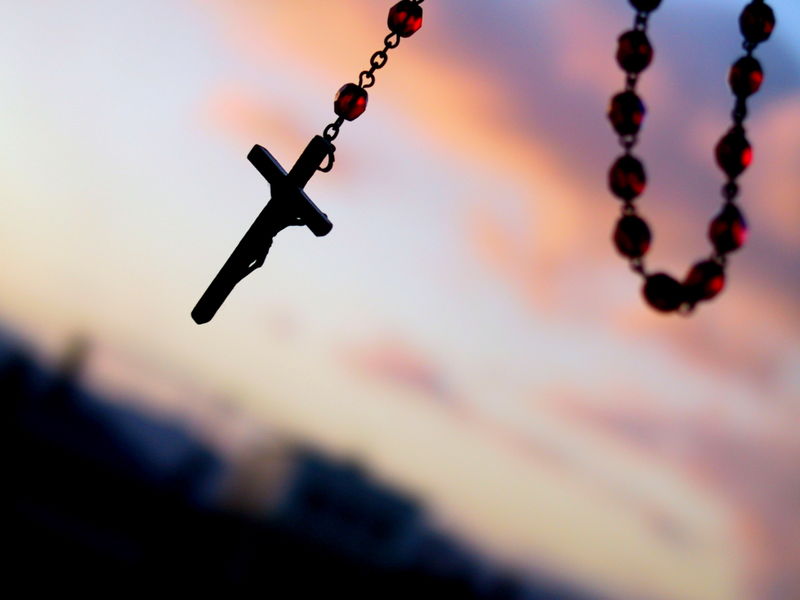While sacramentals have biblical roots, some are surprised to know that the number of sacramentals has changed over the centuries. The Church in her wisdom can change, modify, add, or subtract sacramentals according to the circumstances of the culture.
[featured-image single_newwindow=”false”]Wikipedia [/featured-image]
So how many sacramentals are there? Is there a list where I can go and see all the sacramentals? Before we can discuss any lists of sacramentals, we must first briefly learn the history behind the Church’s compilation of sacramentals.
While sacramentals were present from the very beginnings of the Church, we do not have any compilation of sacramentals until the fifth century. At that time, the Roman Church began putting together all of the liturgical texts of the priest into a single volume called the “sacramentary.” This included, besides the text for celebrating Mass, “the prayers [a bishop] wants at the consecration of a church and many exorcisms, blessings, and consecrations that are now inserted in the Pontifical and Ritual.”
This type of liturgical book was generally used up until the middle ages, when the Rituale Romanum was introduced that separated the prayers at Mass from the various sacramental blessings. During the middle ages each diocese had their own Ritual and so there lacked any uniformity. That is why the Pope Paul V instituted the Rituale Romanum in 1614 that was meant to be used broadly throughout the Church. This book was then revised in 1752 and contained “a large collection of blessings for various objects.”
Since that point the Ritual has been revised multiple times and further refined up until the present time. The list of sacramental blessings has typically been narrowed down throughout the centuries and has been given more direct instructions. However, each diocese (and religious order) is still authorized to make their own supplement to the Ritual and can institute their own sacramentals with the approval of the Pope.
Since sacramentals are instituted by the Church and adapted to the culture, the number of sacramentals has fluctuated and has never had a permanent number. Sacramentals are meant to sanctify everyday life and so depends largely on the current situation in time. What is applicable in the fifth century does not necessarily apply to our current age. They did not have any computers and so a blessing for the Internet would have been quite foreign to them.
This is also why it is nearly impossible to make a complete list of all the sacramentals currently in use. One would need to contact every diocese and religious order throughout the world to determine what sacramentals they have instituted.
Types of Sacramentals
However, at the very least we can categorize sacramentals to get a sense of what they are and how many are out there. First of all, the Church delineates sacramental “blessings (of persons, meals, objects, and places)” as well as exorcisms, which are meant to drive out the presence of evil from places, persons and objects. Blessings of persons include, among others, “blessing of the abbot or abbess of a monastery, the consecration of virgins and widows, the rite of religious profession and the blessing of certain ministries of the Church (readers, acolytes, catechists, etc.).”
Blessings of objects designed for sacred use include, “[t]he dedication or blessing of a church or an altar, the blessing of holy oils, vessels, and vestments, bells, etc.” Sacramental blessings also include such things surrounding “popular piety” as the stations of the cross…the rosary, medals, etc. There are also numerous blessings of objects used for ordinary use such as athletic fields, schools, libraries, fishing equipment, communication machines, blast-furnace, etc. For a much longer list of sacramentals, check out the Roman Ritual and Book of Blessings. Or if you are interested in a book that covers sacramentals that are used in different cultures, you can check out The How-To Book of Sacramentals: Everything You Need to Know But No One Ever Taught You.
In the end, sacramentals encompass a wide variety of blessings, and have remained a part of the Church’s life throughout the centuries. The Church institutes these blessings not to complicate our lives or to make it less biblical, but to infuse our daily lives with extra spiritual graces that will help us to be virtuous Christians.
As we go forward, let us always keep in mind that end and not get caught up with performing all of these rituals for the sake of going through the motions. The worst thing we can do is use these sacramental blessings as some sort of book of “spells” or “incantations” that work like “magic” to achieve a desired result.
Satan likes to mock God and so that is why he has influenced the dark arts in this way and that is why wizards and witches have something similar to the Ritual, but in a much perverted and evil way. Satan seeks to control and possess the world, while God wants us sanctify the world and encourages us to give everything back to Him.

